
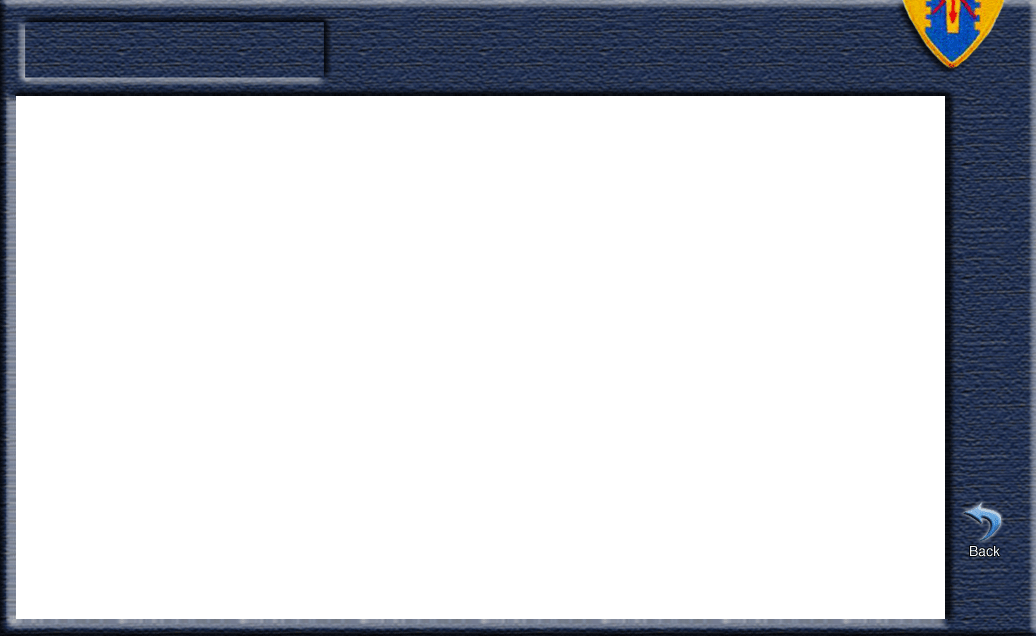
Renegade Woods Battle 2 Apr 1970 - Corrections
Unofficial After Action Report
Phillip John Norton, Collin Hall, Don Purdy, Fred Stuckey - 75th Rangers (2022)
Our Report on What Really Happened Because We Were There
Ranger Teams 38 and 39 were inserted at about 0830 by Centaurs 23 & 24 on the LZ chosen by LT Phillip 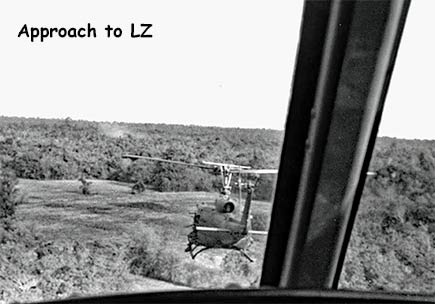 Norton in the Renegade Woods due to enemy activity observed by Centaur 47. The following narrative is intended to present the Rangers’ actions as a timeline from the insertion to the extraction. It is noted that the 25th Div. After Action Report narrative is both incomplete and inaccurate. For example, LT Norton did not lose radio communication when first being fired upon by an enemy light machine gun from the western tree line. Instead, as described by LT Norton below, that happened later. Sources used are the personal testimonies of the Rangers involved, still living, and the 25th Div. After Action Report.
Norton in the Renegade Woods due to enemy activity observed by Centaur 47. The following narrative is intended to present the Rangers’ actions as a timeline from the insertion to the extraction. It is noted that the 25th Div. After Action Report narrative is both incomplete and inaccurate. For example, LT Norton did not lose radio communication when first being fired upon by an enemy light machine gun from the western tree line. Instead, as described by LT Norton below, that happened later. Sources used are the personal testimonies of the Rangers involved, still living, and the 25th Div. After Action Report.
Exiting the two Hueys with suppressive fire into the jungle tree line, team 39 lined up in a defensive position with LT Norton to the left of team 39. Team 38 lined up on Team 39’s immediate right in a defensive position with SFC Floyd on team 38’s left. The Rangers observed enemy footprints and other enemy signs in the LZ clearing of a still unknown enemy designation and size.
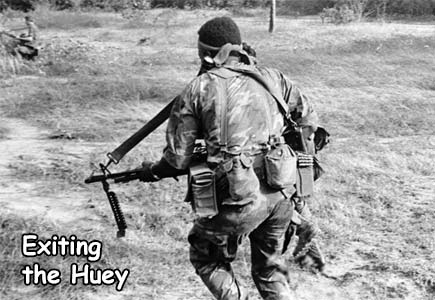 Our immediate communication support was with the Centaur Cobra and LOH Scout pilots and our Ranger 50 communications support site on top of Nui Ba Dinh Mountain, manned very capably that day by Ranger James Anderson. Based on information from the Centaur LOH Scout pilot that a small hootch or bunker lay a few hundred yards to the west, LT Norton in radio communication with SFC Alvin Floyd informed him to line up Team 38 behind Team 39 as LT Norton led the team (with Rangers SGT Stuckey and SP4 Purdy immediately following) around a slender finger of trees and brush with the plan of entering the jungle and moving toward the observed enemy bunker.
Our immediate communication support was with the Centaur Cobra and LOH Scout pilots and our Ranger 50 communications support site on top of Nui Ba Dinh Mountain, manned very capably that day by Ranger James Anderson. Based on information from the Centaur LOH Scout pilot that a small hootch or bunker lay a few hundred yards to the west, LT Norton in radio communication with SFC Alvin Floyd informed him to line up Team 38 behind Team 39 as LT Norton led the team (with Rangers SGT Stuckey and SP4 Purdy immediately following) around a slender finger of trees and brush with the plan of entering the jungle and moving toward the observed enemy bunker.
Immediately, fire from an enemy LMG opened up on the 3 Rangers in front of the file perhaps 10 to 15 feet in front and camouflaged inside the jungle’s edge. LT Norton fell into a bomb crater to his left, uninjured, SGT Stuckey fell 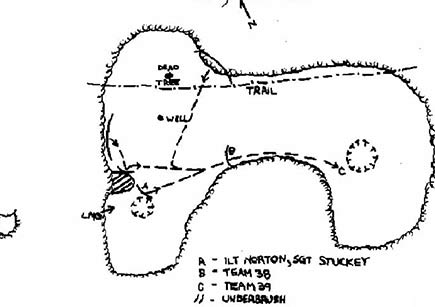 into a slight ground depression partially protected, and SP4 Purdy fell back out of sight of the light machine gun along with the other Rangers. SGT Stuckey had been injured but was still able to fight. LT Norton notified Centaur 47 of enemy fire to our front in the tree line and asked the Centaur Cobra to lay down a base of fire into the immediate tree line. Stuckey and Purdy quickly took out the enemy machine gun with grenades. At that point the Rangers began receiving sporadic enemy fire from the western tree line.
into a slight ground depression partially protected, and SP4 Purdy fell back out of sight of the light machine gun along with the other Rangers. SGT Stuckey had been injured but was still able to fight. LT Norton notified Centaur 47 of enemy fire to our front in the tree line and asked the Centaur Cobra to lay down a base of fire into the immediate tree line. Stuckey and Purdy quickly took out the enemy machine gun with grenades. At that point the Rangers began receiving sporadic enemy fire from the western tree line.
Realizing that the machine gun indicated an unknown enemy force to the team’s front (to the West), LT Norton notified SFC Floyd that he would move the teams to the east and that SFC Floyd should lead Team 38 in laying down a base of fire into the western tree line, while Team 39 led by LT Norton moved to the eastern edge of the clearing, then disengage and follow Team 39. Moving the teams in this synchronized manner with fire and maneuver was critical in keeping the teams together and neutralizing the enemy. It was also necessary to make any organized extraction possible.
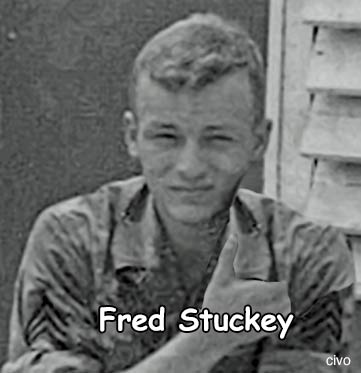 As LT Norton drew close to the eastern jungle edge, he realized the enemy was also there because Team 39 started receiving fire from that tree line. Team 39 returned fire as LT Norton maneuvered the team right up to the edge of the jungle to engage the enemy literally in their face. SP4 Purdy identified one of the enemy’s positions that had opened fire on us and took it out with return fire. LT Norton lined up on the tree line edge on the right with SFC Colin Hall and SGT Fred Stuckey to his immediate left, then SP4 Purdy, SGT Perez, PFC Allmon, PFC Langland, and SGT Seay strung out along the edge of the jungle in close contact with the enemy only a few feet to their front at the edge of the jungle. SGT Seay and SP4 Purdy turned heavy fire on the enemy in the eastern tree line neutralizing enemy fire as did PFC Allmon with his M-60. With covering fire from PFC Allmon, SGT Seay, and SP4 Purdy destroyed another enemy position with hand grenades.
As LT Norton drew close to the eastern jungle edge, he realized the enemy was also there because Team 39 started receiving fire from that tree line. Team 39 returned fire as LT Norton maneuvered the team right up to the edge of the jungle to engage the enemy literally in their face. SP4 Purdy identified one of the enemy’s positions that had opened fire on us and took it out with return fire. LT Norton lined up on the tree line edge on the right with SFC Colin Hall and SGT Fred Stuckey to his immediate left, then SP4 Purdy, SGT Perez, PFC Allmon, PFC Langland, and SGT Seay strung out along the edge of the jungle in close contact with the enemy only a few feet to their front at the edge of the jungle. SGT Seay and SP4 Purdy turned heavy fire on the enemy in the eastern tree line neutralizing enemy fire as did PFC Allmon with his M-60. With covering fire from PFC Allmon, SGT Seay, and SP4 Purdy destroyed another enemy position with hand grenades.
It was at this point that I, LT Norton, realized I had lost radio contact with SFC Floyd whose team was following close behind after laying down covering fire to the clearing’s west edge protecting team 39’s rear. Having lost radio contact I looked behind me and to my left and saw that SFC Floyd had halted his team near a bomb crater on the eastern side of the clearing. All of Team 39 had dropped to the ground prone except for Floyd who remained in a crouched standing position. I believe they were attempting to support Team 39 firing over our heads into the jungle while remaining at our rear.
At this point I witnessed the RPG hit SFC Floyd at about his midsection blowing him nearly in half. I ran to him and realized immediately he was KIA. A Ranger lay unconscious on the ground to SFC Floyd’s right. I turned him over to assess his wounds but could not recognize him as his face had been blown off by the RPG shrapnel. He was obviously KIA. Later I realized that was SGT Michael Thomas. I then turned to the Ranger to SFC Floyd’s left who also lay unconscious slumped over his M-60. That was SP4 Donald Tinney. I dragged him to cover into a bomb crater right behind me and assessed his wounds but other than some light bleeding and being unconscious he did not appear to have immediate life-threatening injuries. Then I removed the radio I carried to assess why I had lost radio contact and discovered that the mic cord had been severed by a bullet at the point that it passed over my right shoulder an inch or two from my head. I returned to SFC Floyd’s body and removed his radio mic (the radio on his back was destroyed by the RPG) which looked to be OK so I attached it to my radio to regain communication.
While I was doing this the following action was happening at the eastern jungle’s edge. SGT Stuckey took out the enemy who had fired the RPG that killed SFC Floyd and then he moved into the tree line to engage an enemy directly in front of him. SFC Hall was wounded by an enemy sniper in the nearby trees. SFC Hall then charged that position and took out that enemy.
After removing SFC Floyd’s radio and mic I looked at the Rangers to my left and immediately in front of me. I remember yelling at them and saw SFC Hall look around at me so I waved him back to me. SFC Hall gathered the Rangers around him and moved to the bomb crater with all the Rangers following.
Upon arriving at the bomb crater and having used most of his M-60 ammo, PFC Allmon gathered Tinney’s M-60 ammo and continued firing into enemy positions at the edge of the jungle clearing. During this part of the fight SP4 Purdy’s M16 became inoperable so he retrieved SGT Thomas’s gear and ammo and distributed it around the crater to other Rangers.
At this point we were nearly completely surrounded and receiving fire from all sides. Though the crater offered some protection we were still exposed. Eleven of us were in the crater, 9 Rangers returning fire on the enemy and Tinney who was unconscious. I was working on regaining communication and then talking to our support who were all the Centaurs above us and our Ranger 50 station on top of Nui Ba Dinh. I shouted at SFC Hall to spread out the Rangers around the crater’s edge to take out enemy targets as they appeared. Realizing SFC Hall was already doing this and that most of the Rangers had already instinctively positioned themselves where they could be most effective, I continued working on getting radio communication.
SGT Avery and SGT Stuckey heard the sound of an M-79 fired by the enemy which then exploded behind us. Stuckey took out that enemy and then directed SGT Perez and PFC Langland (with his M60) to fire at the enemy’s M-79 ammo bag destroying it. SFC Hall silenced a machine gun on the western edge of the clearing. An NVA soldier emerged from the southern tree line to throw a hand grenade but was wounded then killed by two hand grenades thrown by SGT Stuckey. Sometime during this action SGT Avery’s leg had been badly wounded by a sniper so SP4 Guth bandaged his leg with a battle dressing and then returned to the crater’s edge to engage the enemy with Avery’s M16. SFC Hall took out that sniper.
At times like this even 1 minute can seem much longer and the need to regain communication with the Centaur support above us and Ranger 50 como on top of Nui Ba Dinh Mountain was critical to arranging extraction with the window of opportunity getting narrower as we were in a fully blown firefight and expending available ammo and grenades at a fast rate. All of this was happening so fast that it seemed almost a blur as we were operating through our Ranger training by instinct reacting to the enemy threats that were now forming on all sides.
It took me maybe 2 to 3 minutes to reestablish radio contact. The words were initially unclear due to static and broken sentences but became clearer. I first reported our need for immediate ammo resupply and I reported that we had Rangers wounded and down.
By 0920 almost everyone had expended nearly all the ammo and grenades available to the Ranger team. Both the Centaur Cobra and LOH Scout had expended all ammo and were making dry runs in support to help keep enemy heads down and suppress enemy fire. With dwindling ammo, we were close to the point of having to engage the enemy in hand-to-hand combat and escape and evade the enemy by moving to the east through the dense jungle. I asked for extraction but remember that I was told that would be CPT Schierholtz’s decision and that he was not above us but was returning to the 25th Div. FSB in CuChi with the chopper he had been on.
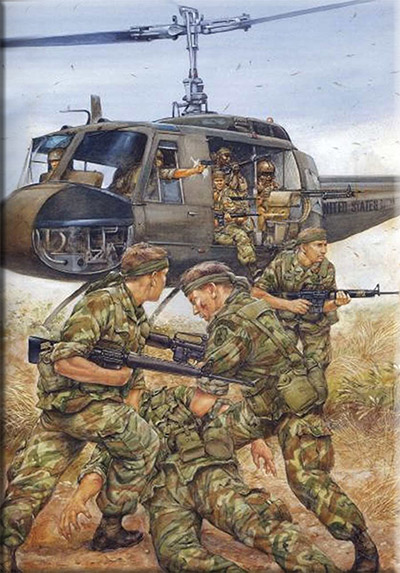 Then I heard the emphatic words, “Suppress your fire, suppress your fire!”. I believe this came from Ranger 50 Jim Anderson who had been monitoring and coordinating our communication with the Centaur support, our Ranger TOC in CuChi, and 25th Division support elements. It was 0922 (as later reported in the 25th Div. AAR) when I saw Centaur 23 coming in from the Northeast to land in the clearing about 150 feet in front of us. I ordered everyone to load on the chopper but that didn’t take much encouragement as we were out of ammo and the rescuing chopper was in front of us. Everyone jumped from the bomb crater and ran to the chopper to board it. SFC Hall led and loaded the chopper quickly by moving and pushing to the middle all the Rangers arriving 1st at the chopper while exposing himself to enemy fire. SP4 Guth and PFC Perez were helping the injured SGT Avery get to the chopper. PFC Langland covered those 3 Rangers with M-60 fire on their way to the chopper.
Then I heard the emphatic words, “Suppress your fire, suppress your fire!”. I believe this came from Ranger 50 Jim Anderson who had been monitoring and coordinating our communication with the Centaur support, our Ranger TOC in CuChi, and 25th Division support elements. It was 0922 (as later reported in the 25th Div. AAR) when I saw Centaur 23 coming in from the Northeast to land in the clearing about 150 feet in front of us. I ordered everyone to load on the chopper but that didn’t take much encouragement as we were out of ammo and the rescuing chopper was in front of us. Everyone jumped from the bomb crater and ran to the chopper to board it. SFC Hall led and loaded the chopper quickly by moving and pushing to the middle all the Rangers arriving 1st at the chopper while exposing himself to enemy fire. SP4 Guth and PFC Perez were helping the injured SGT Avery get to the chopper. PFC Langland covered those 3 Rangers with M-60 fire on their way to the chopper.
I brought up the rear carrying the still unconscious Tinney. As I was about halfway SGT Stuckey looked back, saw me struggling with SP4 Tinney, and came back to help me carry him the rest of the way to the chopper. PFC Richard Adams, the Centaur 23 door gunner, and former Ranger, jumped from the chopper and moved to our left to fire with his M-60 into the woods behind us with suppressing fire. SP4 Don Purdy jumped from the chopper to help us hoist Tinney into the middle of the chopper and then got in with Tinney on his lap to render what 1st aid he could.
Immediately WO Tonelli put the Huey into max torque lift and pulled pitch with only a short run to lift the heavily loaded Huey on an already hot morning over a double canopy jungle. After passing Tinney on to the Rangers in the chopper middle both SGT Stuckey and I tried to find space to board but we were literally hanging mostly out of the escaping chopper being held on only by Rangers inside who were holding on to our equipment webbing to keep us from falling out. After flying a few clicks toward CuChi WO1 Tonelli found a clear, safe landing space to land at Trang Bang so SGT Stuckey and I could safely load into the chopper. Then we flew to the CuChi 25th Div. 12th Evac Hospital to deliver the still unconscienced Tinney.
In seeking and destroying the enemy, Rangers are often the tip of the spear. Our job in special operations varies with the mission but involves finding the enemy, fixing the enemy, destroying the enemy, and gathering intelligence. We often lead before larger military units become involved in what develops into a much larger operation requiring greater resources. We were the tip of the spear that day in finding a large NVA headquarters unit and starting what would amount to a successful 5-day battle for the 25th Division units involved.
There is no doubt in my mind that the exceptional teamwork of the Rangers, the heavy firepower that we laid on the enemy during that 50-minute firefight, and the Ranger’s intrepid bravery caught the enemy off guard and rocked them back on their heels sufficiently before they could get organized giving us time to be extracted by a very brave Centaur crew.
We owe the entire Centaur 23 (Lead Huey) crew with our lives. They were Aircraft Commander WO1 James Tonelli, Pilot CPT Phillip Tocco, Door gunner PFC Richard Adams(a Ranger before joining the ¾ Cav as a door gunner), and Crew Chief SP5 Charles Lowe. Additionally, the following Centaur aircraft and crew covered us with suppressing fire and when their ammo ran out, they made numerous dry runs at the tree tops where the enemy positions were immediately surrounding the clearing. They were Centaur 13 (LOH Scout) crew Pilot WO1 Dan Lohwasser, Crew Chief SP5 Steven Dohry, and door gunner SP4 Michael Bagley; Centaur 47 (Cobra) Aircraft Commander WO1 Kenneth Strand and Pilot WO1 Rog Johnson; Centaur 24 (Trail Huey) crew Aircraft Commander WO1 Marcus Kempson, Pilot WO1 Adrian Williams, Crew Chief SP4 Jack Nemeyer, and door gunner SGT Floyd Hughbanks.
The rest of the story adds to the remarkable story of that firefight and the valor of the Rangers in Teams 38 and 39 and the Centaur support.
Since we had a team in the field and some Rangers were off the 25th Div. FSB, the hybrid heavy team of 13 Rangers (formed by 2 smaller teams designated as T38 & T39) were all volunteers except for SFC Floyd and LT Norton who led the heavy team. SGT Michael Thomas volunteered even though he had only a few days left in country before going home. He had already stood down and had turned in all his gear so he had to borrow another Ranger’s M-16 and gear. SFC Hall on his 2nd Nam tour had been with the company only a short while and was not assigned to either a team or a platoon but was acting as the company operations NCO.
After landing in CuChi the Huey WO1 Jim Tonelli, airship commander, was flying, was inspected by Bell technicians, and was not allowed to fly again before major repairs were made. The damage caused by small arms fire was extensive. Also one of the other Centaur pilots in support reported that as we were lifting off from the firefight clearing he saw an RPG appear to pass between the main chopper blade and the tail boom.
A crucial element of support that was always there for every Ranger operation in the field was the como station we
had at the top of Nui Ba Din Mountain and the skill of the man in charge of that station. For us that day that man was Ranger Jim Anderson. He was ideal for us because he was cool under pressure when we made contact with the enemy and needed him the most. Jim was very skillful in coordinating multiple levels of support while remaining continuously aware of the situation, what support we needed, how to reach out for it, and how to manage it.
The 25th Div. AAR identified the enemy as the 2nd and 3rd Battalions of the 271st Regiment 9th VC/NVA Division whose strength in the Renegade Woods was estimated to be 200 to 300 men. Twelve enemy KIA are recorded to the credit of the Rangers. No doubt the enemy KIA to our credit should have been much greater.
Those 25th Division units in action during the 5-day operation would have counted the enemy dead in the immediate vicinity around the clearing where we waged our firefight and credited them to the Rangers. It is probable that there were more enemy casualties that the Rangers caused that were pulled back as the enemy retreated to the west. These would have been counted later as KIA credit for the other American units. The enemy positions surrounding the clearing where the Ranger firefight took place were found later by the B/C/2-27 to be prepared and fully manned. There can be no doubt that due to our aggressive assault on these enemy positions we Rangers laid a hugh hurt on the enemy who had greater numbers than our 13 Rangers with two brave Rangers KIA and several Rangers wounded.
The 5th paragraph of the Ranger Creed states, “I will never leave a fallen comrade behind to fall into the hands of the enemy.” We had left two Rangers KIA on the battlefield. Feeling I had failed in my duty and failed my Rangers, for more than 30 years I felt survivor’s remorse and guilt. But on that day the decision to do so was mine made quickly based on instinct on what was best for the survival of the remaining team members. SFC Hall was first to the chopper to get all onboard as quickly and orderly as possible. SP4 Guth and PFC Perez helped the badly injured SGT Avery get to the chopper. PFC Langland covered the 3 Rangers with fire on their way to the chopper with his remaining M-60 ammo. SGT Stuckey and I were carrying the wounded and unconscienced SP4 Tinney. There was no doubt that SFC Floyd and SGT Thomas were KIA. I cannot (nor should anyone, not in that fight) hold any Ranger responsible for not attempting to retrieve the bodies of our KIA comrades. There were only a few vital seconds that we had to get the remaining 11 Rangers on board the rescuing chopper. Failing would have cost the lives of 11 Rangers and the brave Centaur 23 crew. The responsibility for the decision was mine alone. SFC Hall & SP4 Purdy (both CSMs retired) and SGT Stuckey have since supported me in making that decision.
The Rangers on Teams #38 and #39 were 1LT Phillip Norton, SFC Alvin Floyd, SFC Colin Hall, SGT Fred Stuckey, SP4 Don Purdy, PFC Raymond Allmon, SGT Charles Avery, SP4 Richard Guth, PFC Kenneth Langland, PFC Steven Perez, SGT Samuel Seay, SGT Michael Thomas, and SP4 Donald Tinney.
Photos by CPT Paul Schierholz,
Additonal Data from original After Action Report (with corrected spelling)
Centaurs that were interviewed for the original report
Bagley, Michael R.; SP4; Gunner, D/3-4 Cav
Dobry, Steven L,; SP5; Crew Chief; D/3-4 Cav
Johnson, Roger; WO1; Pilot, D/3-4 Cav
Kempson, Marcus A.; WO1; A/C, D/3-4 Cav
Lohwasser, Dan A. III; WO1; Pilot, Pilot, D/3-4 Cav
Strand, Kenneth L.; WO1; A/C, D/3-4 Cav
Tocco, Philip A.; CPT; Pilot, D/3-4 Cav
Tonelli, James D. R.; WO1; A/C, D/3-4 Cav
Williams, Adrian K.; WO1; Pilot, D/3-4 Cav
Helicopter Crews During the Ranger Contact
AH-1G Cobra (Centaur 47)
Strand, Kenneth L. WO1 Aircraft Commander
Johnson, Rog WO1 Pilot
OH-6A Light Observation Helicopter (Centaur 13)
Lohwasser, Dan A., II WO1 Pilot
Dobry, Steven L. SP5 Crew Chief
Bagley, Michael R. SP4 Doorgunner
Lead UH-1H (Centaur 23)
Tonelli, James D.R. WO1 Aircraft Commander
Tocco, Philip A. CPT Pilot
Lowe, Charles E. SP5 Crew Chief
Adams, Richard K. PFC Doorgunner
Trail UH-1H (Centaur 24)
Kempson, Marcus A. WO1 Aircraft Commander
Williams, Adrian K. WO1 Pilot
Nemeyer, Jack M. SP4 Crew Chief
Hughbanks, Floyd L. SGT Doorgunner